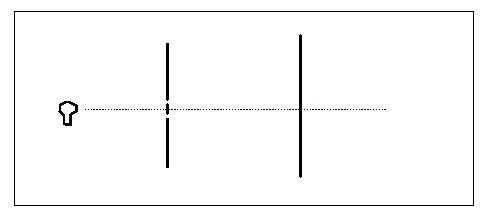BUCKNELL UNIVERSITY
Astronomy 102
First Hour Exam
|
February 16, 2000
|
This Exam will be scored on a 100 point scale and has two parts: a multiple
choice/short answer section of 10 questions each worth 5 points and a problem
section with 3 problems, each worth 16 points. You get 2 points for writing
your name and seat number.
Name & Seat# ______________________
Here are some quantities and relationships that you might find useful.
Remember that you may use your notes and/or the textbooks for this exam.
for a wave: speed = wavelength x frequency
the speed sound in air: cs = 340 meter/sec,
the speed of light: c = 3 x 108 meter/sec
for light waves: energy = h x frequency = h x c/wavelength
Planck's constant: h = 6.626 x 10-34 Joule
x sec
Doppler formula:
speed of emitter change
in frequency
------------------- = --------------------
speed of wave
rest frequency
wavelength of spectrum peak (in nanometers) =(3 x 106
nm K)/temperature
1 nanometer = 10-9 meters
for blackbody emitters: intensity = sigma x (temperature)4
sigma = 5.67 x 10-8 W/(m2 K4)
luminosity = intensity x surface area, or: Intensity
= luminosity/area.
for a sphere: surface area = 4 x p
x radius
magnitude scale: difference of one magnitude corresponds
to a factor of ~2.5 in intensity
distances: 1 Astronomical Unit (1 earth-sun distance)
= 1.495 x 1011 meter
luminosity (power!) of the sun: 1 Lo = 3.8
x 1026 Watt
1eV = 1.609 x 10-19 Joule
Part I: Multiple Choice Questions:
1) A slinky is wiggled 10 times in 5 seconds. The distance between waves
crests in the slinky is found to be 0.5 meters. The speed of the wave in
the slinky is therefore
2) Lines of decreased brightness in the rainbow spectrum of a G2 star are
probably due to
3) Light from a light bulb passes through a screen with two small openings
and because light is a wave, produces an interference pattern of light
and dark fringes on the second screen. What would you see on the second
screen?

4) If you move at a very high speed away from a red traffic
light you may see it (in your rear view mirror) as a
-
a) a dark traffic light
-
b) a negative picture: the red is green, the yellow is the same, and the
green turns red.
-
c) green traffic light
-
d) more massive red traffic light
5) Satellite dishes absorb
6) Alpha Centauri, a G2 star, is 4.3 Light Years from earth. It has an
apparent magnitude of 0.0. The G star 104-Tori in the constellation Taurus
has an apparent magnitude 5.0. That second star is
7) Two spheres with 100 Watt power are located at the same distance
from an observer. The first has a surface temperature of 2000 K, while
the second has a surface temperature of 3000 K. We can therefore conclude
that:
-
a) the second sphere is brighter
-
b) the size of the second sphere is smaller
-
c) the color of the first sphere is green, and that of the second is red.
-
d) the peak brightness of the second sphere is not in the Infra Red.
8) Helium atoms have the following energy levels:
Third excited state ___________________________
51 eV
Second excited state ____________________________ 48.4 eV
First excited state ____________________________
40.8 eV
Ground state
_____________________________0.0 eV
Given that these atoms are in the second excited state, they can absorb
a photon of which of the following energies?
-
a) 40.8 eV
-
b) 7.8 eV
-
c) 2.6 eV
-
d) 51 eV
-
e) both a) and b)
9) Of the two stars of type G2 and G9 which one has the hotter surface?
-
a) The G2 star
-
b) The G9 star
-
c) Star types are not related to surface temperatures.
10) Two stars are of types O2 and K9. The O2 star has ____ than the K9
star.
Part II: Problems:
(Show your work!! I will be very generous with partial credit!!!)
Problem 1) Two stars, both in the Hyades
cluster, have the same surface temperature of 2500 degrees Kelvin.
a. (6 points) What is the color of these stars?
Answer
b. (6 points) If the first star has an overall surface area that is
roughly two and a half times that of the second star, how much brighter
will it be?
Answer
c. (3 points) If the magnitude of the first star is +12.3, what will
be the magnitude of the second star? (3 sig. figs here please!)
Answer
Problem 2)
a. (10 points) How would you find how many microwave photons (wavelength
= 106 nm) it take to equal the energy of one X-ray photon (wavelength
= 1 nm)? Explain in ~ two or three short sentences.
Answer
b.(6 points) If the space shuttle moves at 105 meters/second
towards a microwave emitting communication center (wave length of emitted
microwaves = 106 nm), what will be the frequency received
by the space shuttle?
Answer
Problem 3) A giant tenuous cloud of excited
neon, hydrogen and oxygen gasses has just been observed in the remnants
of a blown-up star by the Chandra X-ray satellite and other telescopes
(American Astronomical Society press release, January 15, 2000).
a. (6 points) In lab and in class we noticed that neon and hydrogen
have different spectra. Which gas has more lines in the visible part of
the spectrum?
Answer
b. (6 points) Which of these gasses, neon and hydrogen, would have more
lines in the X-ray part of the spectrum? (Hint: O stars don't have many
hydrogen lines. Also look at question 10 in part I.)
Answer
c. (3 points) The emission lines from neon in the X-ray part of the
spectrum are fainter than the lines of oxygen in X-rays . What information
can you get from this fact?
Answer

